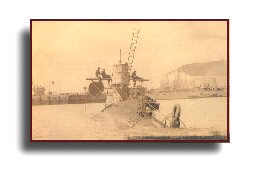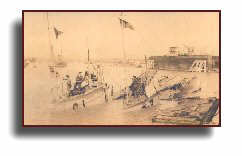| Harry Coward was engineer on C.1, one
of the two submarines which took part in the raid on Zeebrugge. These photographs
show those two vessels in Dover Harbour preparing for the raid.
The commander of submarine C.3, Lieutenant
Richard Sandford, received the Victoria Cross, one of 8 awarded as a result
of the action. He and the crew had manoeuvred C.3 into position under a
viaduct and detonated the five tons of amatol secreted in the bows of the
submarine, thereby preventing German re-inforcement.
Lieutenant R. D. Sandford
An account of
the action and the Citation
William Henry Ridsdale Coward was born
in Adelaide, and moved to Great Britain with his mother and siblings around
the turn of the 20th century. After the war, he returned to Australia (by
submarine, I believe), and settled at Chatswood.
More
on Harry Coward
My grandfather, Henry Coward,
was a submariner. These ribbons and photographs were given to me by my
family, Christmas 1997. There is mention of Harry Coward in a letter
from my mother, Constance I White, ne Coward.
There were no annotations
on the back of the photographs. I placed them on this site in the hope
that someone could shed more light on the issue. The Royal Navy Submarine
Museum, Hampshire UK, identified the photographs, and I have used their
captions where possible. |




![]()





![]()